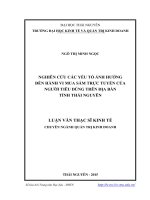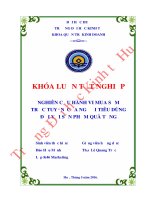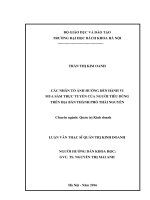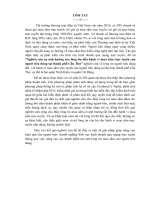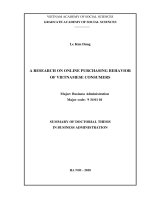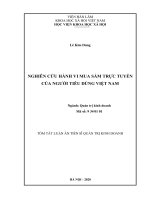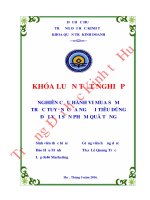Nghiên cứu hành vi mua sắm trực tuyến của người tiêu dùng việt nam tt tiếng anh
Bạn đang xem bản rút gọn của tài liệu. Xem và tải ngay bản đầy đủ của tài liệu tại đây (287.79 KB, 27 trang )
VIETNAM ACADEMY OF SOCIAL SCIENCES
GRADUATE ACADEMY OF SOCIAL SCIENCES
Le Kim Dung
A RESEARCH ON ONLINE PURCHASING BEHAVIOR
OF VIETNAMESE CONSUMERS
Major: Business Administration
Major code: 9 34 01 01
SUMMARY OF DOCTORIAL THESIS
IN BUSINESS ADMINISTRATION
HA NOI - 2020
HÀ NỘI - 2018
The thesis was completed at Graduate Academy of Social Sciences
Academic Supervisor:
1. Assoc.Prof. Dr. Le Huu Anh
2. Dr. Nguyen Binh Giang
Reviewer 1: Assoc.Prof. Dr. Hoang Van Hai
Reviewer 2: Assoc.Prof. Dr. Nguyen Van Thao
Reviewer 3: Assoc.Prof. Dr. Vu Huy Thong
The thesis is defended against Academy-level Examination Board at
Graduate Academy of Social Sciences
Time: ………… date………month……….year……………
The thesis can be found at: National Library of Vietnam and Library of
Graduate Academy of Social Sciences.
LIST OF THE AUTHOR’S PUBLICATIONS
IN ASSOCIATION WITH THE THESIS
1. Le Kim Dung (2018), “Study the factors influencing online shopping
behavior of Vietnamese consumers by expanded DTPB theory”, Economy
and Forecast Review, Issued 21 July 2018 (697), ISSN: 0866-7120, pp.3740.
2. Le Kim Dung (2018), “Review of Consumer’s Shopping Online Behavioral
Models”, Journal of Asia - Pacific Economic Review, 06/2018, ISSN: 08683808, pp.51-53.
1
INTRODUCTION
1. The necessity of the research
In the era of industrial revolution 4.0, e-commerce has grown
very quickly in the world and in Vietnam. Online shopping is
becoming an indispensable trend in the context of Industry 4.0, when
Vietnam is one of the six countries with the largest and most
developing Internet and digital economy in and out of the region
including: India, Malaysia, Philippines, Singapore, Thailand and
Vietnam, estimated to reach about 200 billion USD by 2025 with the
rapid increase in the number of Internet users, as well as the number
of people using and will use smartphones with both young and large
population and high levels of education and average income. Buying
goods online is a natural trend and indispensable thanks to the
development of the Internet. To sustain and develop grow ecommerce business, retailers face challenges not only to attract new
customers, but also to retain existing customers and to find solutions
to customers finding their websites. Thus, the question is how to
exploit the needs of the online retail market in Vietnam? Studying on
shopping behavior of Vietnamese online consumers is essential for
the development of effective online business models at the beginning
of development. Therefore, in order to understand the behavior and
factors affecting online shopping behavior of Vietnamese consumers,
the author chooses a research perspective through understanding
online shopping behavior of the youth by the topic "A Research on
Online Shopping Behavior of Vietnamese Consumers" to identify
and describe the characteristics of Vietnamese consumers in the
online shopping process, as well as identify and analyze the key
factors affecting online shopping behavior of consumers. The
2
dissertation's findings contribute to the sciences for the online
shopping process, as well as to bring practical value to businesses in
the strategy of building compatible systems and policies.
2. The purpose and task of the research
2.1. The purpose
On the basis of generalizing and supplementing some
theoretical issues about online shopping behavior, the author clarifies
the analytical framework of the thesis, uses an analytical framework
to describe online shopping behavior of Vietnamese consumers,
factors affecting their online shopping. Then, propose management
implications and recommendations to improve online business
activities in Vietnam.
2.2. Task of the research
(1) Study and develop a theoretical framework for online
shopping behavior; (2) Develop and validate a scale of online
shopping behavior to use for online business; (3) Build a research
model of online shopping behavior of Vietnamese consumers; (4)
Test the proposed research model with actual data collected from the
research sample; (5) Measure the importance of the factors affecting
online shopping behavior, thereby proposing solutions for online
business; (6) Propose implications for online retailers.
3. Object and scope of the research
3.1. Object of the thesis
Is online shopping behavior of Vietnamese consumers.
3.2. Scope of the thesis
- About the content: The thesis applies the theoretical model of
online shopping behavior in the world as a theoretical framework for
developing online shopping behavior model in Vietnam; Analyze the
3
stages in the process of online consumer behavior; Find out the factors
that influence online shopping behavior of Vietnamese consumers;
Provide policy implications to enhance online shopping decisions to
promote the development of Vietnam's online business market.
- About space: The research mainly focuses on the Vietnamese
consumer aged from 18 - 45 in three cities representing the North,
Central and South are Hanoi, Da Nang and Ho Chi Minh City.
- About time: Survey data were conducted from 2010 - 2018.
Primary data was implemented in 2017 - 2018.
4. Methodology and research methods of the thesis
4.1. Methodology of the thesis
The author uses and combines a system of popular methods
such as analysis, synthesis, and technical methods such as statistics,
description, comparison, evaluation, and interview, sociological
surveys... all to create useful tools to collect the best information for
the thesis. By reviewing published research documents on online
shopping behavior, the author provides basic theoretical and practical
as trends for discussion of the thesis.
4.2. Research methods of the thesis
Preliminary studies are conducted by qualitative and
quantitative research methods. These preliminary studies were
conducted in Hanoi. Qualitative research was conducted through
expert interviews and focus group discussions.
The formal study was also conducted by quantitative research
method by direct interviewing. Official research was conducted in
three major cities: Hanoi, Da Nang and Ho Chi Minh city.
4
5. New contributions of the thesis
The study contributes a number of new findings on the online
shopping behavior of Vietnamese consumers. The application of
theories of behavior to the stages of the online shopping decisionmaking process opens up a new research model that exploits the
continual relationship between online information search behavior and
online shopping behavior. The research model of the thesis analyzes the
process of transforming the stages of online consumer behavior. In
addition, the model presents the factors that influence the process of
transforming the stages of online consumer. These factors are the basis
for online retailers to orient their approach to online customers.
6. Theoretical and practical meanings of the thesis
6.1. Theoretical of the thesis
The results of this study are of scientific significance when
contributing to new development, enriching theories on online
shopping behavior of consumers (including Vietnamese consumers).
6.2. Practical meanings of the thesis
The results of the study help online retailers understand the
role of the factors affecting the online shopping decisions of
Vietnamese consumers as well as specific criteria for each factor.
Thereby, they can build marketing and advertising programs in the
right direction to improve business efficiency.
The thesis proposes some management implications to
improve the efficiency of online business activities which are
feasible and valuable for retailers to promote online shopping of
Vietnamese consumers.
7. The structure of the thesis
5
The main content of the thesis consists of 5 chapters. In
addition to the introduction, conclusion, references and appendices,
the thesis contents as follows:
Chapter 1: Overview of research works on online shopping behavior.
Chapter 2: Theoretical foundations and research models.
Chapter 3: Research methodology.
Chapter 4: Research results and discussion.
Chapter 5: Management implications to improve the
efficiency of online business.
Chapter 1
OVERVIEW OF RESEARCH WORKS ON ONLINE
SHOPPING BEHAVIOR
1.1. The research works in the world
Rong Li et al. (2007) analyzes the factors influencing online
shopping intention. In particular, the trust has been shown to be an
important factor affecting the purchase intention of Chinese consumers.
In the research model, the trust variable is an intermediary variable
between independent variables such as knowledge of e-commerce,
perceived reputation, perceived risk, perceived ease of use, and
dependent variable intention to buy. Through the research results, the
authors have shown that there is a strong relationship between trust and
purchase intention. And they believe that Chinese online retailers want
to compete with others should consider trust as the first important factor
that needs to be built. Factors as knowledge of e-commerce, perceived
risk, and perceived ease all affect trust. Particularly, perceived reputation
has no effect on trust. The author also explains that because there are
some big websites in the field of shopping in China and they occupy
most of the market share. When Chinese customers do online shopping,
6
they mainly go to these websites, so the study of the perceived
reputation factor does not have much influence on trust.
Empirical research on the factors influencing the attitude and
intention of online shopping by consumers in Bankok, Thailand by Ma
Mengli (2011) is a meaningful contribution to online business in this
country. Research results have shown that only three of the five factors
that influence online shopping attitudes are perceived ease of use,
perceived usefulness and trust. Those exclusion factors are individuality
and safety and perceived risk. In addition, the study also shows that
demographic factors do not affect much on purchasing behavior. The
reason for this is because the female population in BangKok is mostly
having job and their education level is equal to the male, and they also
have many opportunities to access the Internet.
In Gotland, U Sultan & M Uddin (2011) studies customer
attitudes towards online shopping. The results of the study suggest that
there are four influencing factors for online shopping in Gotland, of
which the strongest impact factor is website design / features, followed
by convenience, time saving and security. The study also found that
there are a number of other factors that influence the intention of online
shopping behavior including price, discount, feedback from previous
customers and the quality of the product.
In Korea and the United States, Joongho Ahn et al., (2001) built
an E-Cam acceptance model by integrating TAM model of Davis
(1986) with theory risk TPR (Bauer, 1986). This model shows the
factors that influence the transition from Internet users to potential
consumers of different cultural regions.
In the US, Patricia Sorce et al. (2005) examines online shopping
behavior and direct purchasing behavior among young people and the
7
elderly through their attitudes towards shopping. The results show that
older people search online information less than young people, they are
actually more likely to buy directly than younger consumers. This result
shows that attitude influences online shopping behavior, while age
affects purchasing behavior for the first time.
The study of Sita Mihra (2014) uses Ajzen's intended behavior
theory model (1991) to study the factors that influence Indian
consumers' intention and online shopping behavior. The results show
that attitudes, subjective standards and capacity to control behavior have
a positive impact on intention, but subjective standards have a negligible
impact on behavioral intention. And as well as the conclusion of Ajzen
(1991), Sita Mihra (2014) also find a positive relationship between
intention and behavior. Attitude is the most important factor influencing
purchasing intentions followed by awareness of ability to control
behavior. Therefore, if marketers create a positive attitude towards
online shopping in mind of consumers, it will lead to higher intention
and ultimately real buying behavior.
Mehrdad Salehi (2012) conducts a research on consumer
buying behavior for online stores in Malaysia. This study is
conducted to identify factors affecting consumers for online
shopping in Malaysia. The study focuses on nine independent
variables: website appearance, quick access, information security,
sitemap, relevance, promotion, attractiveness, trustworthiness and
originality. The findings of the study indicate that the first five
factors that influence consumers on online shopping and security are
the most contributing factors to online shopping.
Mohammad et al. (2012) use a model to examine the impact of
cognitive risks, facilities and return policy on attitudes to online
8
shopping and subjective standards, and perceptions of self owners in
specific behavior, creative domains and attitudes about online shopping
behavior. The findings identify financial and non-delivery risks that
negatively affect attitudes to online shopping. The study also shows that
specific creativity and subjective norms positively influence online
shopping behavior. Moreover, attitude also positively influences online
shopping behavior of consumers.
Shu-Hung Hsu (2012) studies factors that influence the
attitude and intention of online shopping by Mongolian consumers.
The purpose of this study is to investigate Mongolian consumers'
perceptions of online shopping, as well as factors that influence their
attitudes and intentions for online shopping. Research results show
that consumer innovation, perceived benefits and risks are important
determinants of online shopping. In addition, the findings show that
consumer innovation, perceived benefits have a positive impact on
consumer shopping attitudes, and perceived risks that have a
negative impact on online shopping attitudes of consumer. Moreover,
consumer innovation, perceived benefits and risks have an indirect
effect on the intention to shop online.
From the perspective of online shopping consumers, Jin et al.,
(2014) assesses the relationship of two factors: awareness of usefulness
and trust in online shopping behavior of customers in Northern
Malaysia. Because most of the previous studies focused on the intention
than online shopping behavior in relation to the final stage of buying and
selling. The research results show that perceived usefulness and
reliability are important factors affecting online shopping behavior of
consumers in Northern Malaysia. The integrity and reputation of online
retailers is very important in consumers' decision to shop online because
9
the greater the consumer confidence, the more engaged they will be in
buying online activities.
1.2. Domestic research works
Shyh-Hwang Lee and Hoang Thi Bich Ngoc (2010) examines
an integrated model that extends the theory of planning behavior
with an additional factor of trust by investigating intentions of online
shopping behavior for Vietnamese university students. Through the
results of the study, the more trust increases, the more intention leads
to online shopping behavior. With three attitude variables, subjective
norms and perceived control of individual behavior of TPB model,
trust is an important factor in the relationship between attitudes and
intentions of online shopping behaviors.
Researching factors affecting online shopping intention of
customers in Hue city by Duong Thi Hai Phuong (2012) selected the
technology acceptance model (TAM) as the basis. According to the
research results, perceived benefits (PU) is the most important factor
affecting customers' intention to shop online in Hue City. This factor
is constituted by the diversity of goods and services, the convenience
of shopping, the price of goods / services is cheap, informative and
entertaining. In addition, research shows that product attributes,
product information directly impact customers' online shopping
intentions, minimizing risks for customers when shopping online.
In the study of Nguyen Thi Bao Chau & Le Nguyen Xuan Dao
(2014), the belief factors, the variety of goods choices, prices,
website responsiveness, comfort, convenience, factors such as time
risk, product risk, and financial risk affect consumers' online
shopping decisions. Research shows that the comfort factor is the
most important factor in online shopping decisions. The two groups
10
of people who have never been shopping and have experienced
online shopping have differences in online shopping behavior, the
two groups are strongly influenced by the factor of diversity in goods
selection, and here are the factors that distinguish the two groups of
online shopping objects.
When studying the role of beliefs in Vietnamese consumers'
online shopping intention, Ho Thi Phuong Lan (2014) based on the
TAM theory model (Davis, 1985) to study the factors of trust.
Beliefs like trust in technology, trust and belief in society, these are
the factors affecting online shopping intentions. Accordingly, the
online suppliers of goods / services have high reliability, the
proportion of consumers making more purchasing decisions.
The research and assessment of factors affecting the online
purchase acceptance of individual customers in Hue city by Nguyen
Thi Minh Tam (2014) was based on the proposed scale of the TAM
model of five factors: Ease of use, usefulness, risk perception,
product and company characteristics, customer experience. Based on
that, the author offers a number of solutions to assist businesses in
stimulating customers.
Researching the factors influencing customers' decision to buy
online voucher in Da Nang city by Nguyen Duy Phuc (2014) has
adopted two research models of Xiang Yan and Shiliang Dai as the
basis for the proposal. Research and testing models of factors that
perceive customers' benefits and risks affecting the decision to buy
voucher online in Da Nang. Also consider whether these factors differ
from each other by gender, age, occupation, income and marital status in
a customer's purchase decision for this type of service. Through the
author's research on customer perceptions affecting the decision to buy
11
online voucher in the city area. Da Nang has overlapping and
complementary components with the previous two studies, perceived
benefits are also measured by five factors: price reduction; product
characteristics;
product
choice;
convenient
shopping;
enjoy
shopping. From there, the author proposes two groups of solutions:
price solutions, and product solutions.
Ha Ngoc Thang & Nguyen Thanh Do (2016) conduct research
Factors affecting online shopping intention of Vietnamese consumers:
an extensive study of planned behavioral theory. The confidence
variables and perceived risks are added by the authors to the DTPB
model to predict consumers' intention to buy online. The study found
that trust, perceived risk, attitudes and perceptions of controlling
consumer behavior influence consumers' online shopping intention.
Meanwhile, the reference group did not affect the intention to buy
online, but the attitudes, beliefs and awareness of behavioral control
positively affected consumers' intention to buy online. Perception of risk
is a factor proven to reduce customers' intention to buy online.
A study of factors affecting customer satisfaction when
shopping online in Kon Tum City by Nguyen To Uyen (2016)
examines the factors from the process before, in and after buying.
The research results show that there are six factors: (1)
Characteristics of goods, (2) Quality of information, (3) Feedback,
(4) Payment methods, (5) Customer service and (6) Product quality is
related to customer satisfaction online shopping. In particular,
commodity characteristics and information quality are the two factors
that have the most impact on online satisfaction. Research has shown
that pre-purchase services have the potential to impact customer
satisfaction. Since then, the study proposes a number of solutions to
12
business administrators to adjust products and support services before,
during and after the purchase to increase customer satisfaction.
Tran Thi Hong Hanh (2017) in the study Factors influencing
online household shopping behavior are female office workers in Hanoi
who choose to consider four factors that influence their household
purchasing decisions. Online use of female office workers in Hanoi
includes: (1) Convenience; (2) Prices and brands; (3) Website
responsiveness; (4) Risks when shopping online. These four factors are
selected by the author on the basis of inheriting, synthesizing and
developing from previous studies. In addition, the model also considers
the influence on online shopping decisions of four demographic
variables: marital status, age, job title and average income.
Researching the relationship between online service quality,
beliefs and online shopping intention of Vu Thi Tuong Vi (2017)
analyzes the impact of factors of online service quality on the belief
of customer. Measure the influence of trust on intentions in online
shopping. The study has synthesized factors: aesthetic interface,
technology, financial security in online service quality affecting trust
and intention of online shopping. Discover the difference between a
customer base on a trust relationship and an intention to shop online.
1.3. The conclusions from the study review
- Studies have shown a variety of factors that influence
consumer intention - online shopping behavior. However, these
studies: (1) are focused on research in developed countries with
developed infrastructure and economy. Therefore, to provide an
online shopping behavior model suitable for the Vietnamese market,
the above studies have not been met. (2) Lack of research on online
13
shopping process in the context that consumers choose between
online shopping and traditional shopping in Vietnam.
- Studies have not yet analyzed in-depth consumer behavior, into
the process of connecting between variables in the online shopping
process. Therefore, it is necessary to integrate more diverse from many
models, other aspects of online consumer behavior research.
Chapter 2
THEORETICAL BASIS AND RESEARCH MODEL
2.1. Overview of online shopping
2.1.1. E-commerce concept
E-commerce is defined as the delivery of goods, services,
information and payments through computer networks or other
electronic devices (Turban et al., 2006).
2.1.2. Online shopping concept
Inheriting and combining the previous concepts, the author
generalizes the concept of online shopping as follows: Online
shopping is defined as the service that consumers use electronic
devices with Internet connection for shopping deals.
2.2. Differences between online shopping and traditional shopping
Firstly, it is the difference in "technical conditions for
procurement". Second, some online retailers do not accept cash
payments. Third, the factor of direct contact with the product.
Fourth, the ability to access the number of points of sale at any time
between the two shopping modes.
2.5. Theoretical overview of consumer behavior
2.5.1. Reasonable Action Theory (TRA)
Fishbein & Ajzen (1975) designed TRA to explain the general
behavior of humans. TRA expands the relationship between human
14
attitudes (A) and behaviors (B) toward the intention of behavior (BI)
before an action is taken.
2.5.2. The theory of planned behavior (TPB)
Compared to TRA, the TPB model adds behavioral control
cognitive factors that influence behavioral intention. In addition, the
belief factor about convenience has an impact on the cognitive factor
about behavior control.
2.5.3. Technology Acceptance Model (TAM)
The difference between TAM and TRA firstly is that TRA
explains behaviors in general, while TAM predicts information
technology usage behavior (Davis, 1986). TRA has a wider scope
than TAM, TAM is a special case of TRA. Second, in the TAM
model, behavioral planning (BI) is influenced by attitude (A) and
perceived usefulness (U), while behavioral prediction in TRA model
is influenced by subjective attitude and standards.
2.5.4. Model Buying decision making process
In the field of marketing, Engel, Kollat & Blackwell (1973)
extended Simon's (1978) decision-making model into a model of
Consumer Buying Decision Making, consisting of five steps: (1) The
demand; (2) Search for information; (3) Evaluation of alternatives;
(4) Make a buying decision; (5) Post-purchase behavior.
2.6. Factors affecting online shopping behavior of consumers
+ Group of environmental factors as technological factors;
socio-cultural factors such as information overload, personal
narrowing, security issues and personal information, borders
between housing and work, convenient features at anytime,
anywhere, limited time, ability to meet the expectations of the
demand, self-service mode, a group of smart, stylish customers,
15
personalized, easy, multi-channel purchasing trend.
+ Group of factors about personality, characteristics, personal
resources to buying behavior of electronic customers.
+ Group of factors on the source factors to the purchase
behavior of electronic customers such as the cost of money, the cost
of effort spent in the process of electronic purchases and the buying
psychology of electronic customers.
2.11. Adjust the research model in the context of research in
Vietnam
Research gaps need to be supplemented in this study in
Vietnam: People make rational choices; The stages of consumer
behavior on the Internet are consecutive sequences of behavior;
When trying to shop on a new shopping channel, consumers compare
new channel vs traditional shopping channels; Online shopping is
considered a risky choice for most consumers; A sense of ease of use
and a sense of usefulness are two natural characteristics for most
consumers. This assumption is the premise for the development of
rational action theory TRA; Perceiving risks and comparing buying
efforts, comparing search efforts brings negative feelings to most
consumers; Comparing the availability of information, comparing
purchasing convenience, comparing service quality, comparing
purchasing efforts, and comparing search efforts is a common
practice for most consumers.
2.12. Research model of online shopping behavior of Vietnamese
consumers
The author proposed a research model consisting of eight
factors (independent variables): perception of usefulness, perceived
ease of use, perceived risk, comparison of information availability,
16
comparison purchasing effort, comparison of search effort,
comparison of purchase convenience, comparison of service quality
impacting on two factors (dependent variable) are online information
search and online buying decisions for Vietnamese.
Chapter 3
RESEARCH METHODS
Based on the theories of online shopping and research models
of online shopping behavior of Vietnamese consumers presented in
chapter 2, in chapter 3, the thesis designs the research process for
submission, presents analytical methods on the state of online
shopping, methods of testing factors affecting online shopping
behavior of Vietnamese consumers.
The author presents a two-stage research method: Preliminary
research and formal research, and the research process of the thesis.
In this section, the author presents two specific research methods:
qualitative and quantitative research. From the results of qualitative
research, the author built a scale to evaluate in detail the factors
affecting online shopping behavior of Vietnamese customers.
Specific criteria in the research model are measured by a 5-level
Likert scale with an evaluation scale from 1 to 5. For categorical
variables such as gender, age, occupation, income,… measured by
nominal or hierarchical scales.
The analysis method is based on three steps: verifying the
reliability of the scale, analyzing the appropriateness of specific criteria
for each variable in the model and analyzing the structural SEM model.
In this chapter, the author also clearly describes the sampling
method and data collection plan, the data analysis method. Research
samples in three areas: Hanoi, Da Nang, and Ho Chi Minh City: The
17
number of questionnaires issued was 1.000, collecting 905 votes, but
after screening and removing invalid votes, the survey results were
collected. Suppose only 816 valid votes are used for official analysis.
The size and structure of the research sample is consistent with the
requirements of the study design and ensures the overall
representation. The research results are therefore more likely to
reliably reflect the picture of the whole.
After conducting expert interviews and group discussions, the
author has adjusted the proposed research model, the research
hypotheses, specific criteria for each variable in the model, and
restated the hypotheses and research theory. The research model
remains the same as the proposed research model, adjusting only the
names of the five factors. The author examines the research model
and presents the research results presented in chapter 4.
Chapter 4
RESULTS AND DISCUSSION
4.1. Descriptive results about online shopping behavior
4.1.1. Average time of Internet access / day of consumers
4.1.2. Number of consumer online purchases per year
4.1.3. Statistics combine the average time of Internet use / day and
the number of online shopping
4.1.4. The products are usually purchased online
4.1.5. The online shopping channel of consumers
4.1.6. Form of payment for products and services ordered online
4.1.7. Factors consumers care about online shopping and interest in
online sellers
4.1.8. Factors that consumers are most interested in when shopping
online and are interested in online sellers
18
4.1.9. Differences in online shopping behavior of Vietnamese
consumers compared to other countries
4.2. Test results of specific criteria for each variable
4.2.1. The reliability test results of specific criteria for each variable
by Cronbach’s Alpha
4.2.2. Test results of reliability of criteria expressed by discovering
factors (EFA)
4.2.3. Test results of criteria presented by positive factor analysis (CFA)
4.3. Results of testing models and research hypotheses
4.3.1. Results of testing the conformity of the research model
4.3.2. Test the research hypotheses H1 to H8
After performing research hypotheses from H1 to H8 using
linear structure model (SEM), we can see:
- H1: Perception of usefulness has a positive relationship with
online information search behavior of Vietnamese consumers (β =
0.112; p <0.05), so hypothesis H1 is supported.
- H2: Perception of ease of use has a positive relationship with
online information search behavior of Vietnamese consumers (β =
0.330; p <0.05), so hypothesis H2 is supported.
- H3: Online information search behavior has a positive
relationship with online shopping decisions of Vietnamese
consumers (β = 0.094; p <0.05). Support for hypothesis H3.
- H4: Shopping convenience has a positive impact and is
statistically significant with Vietnamese consumers' online shopping
decisions (β = 0.260; p <0.05). Therefore support the hypothesis H4.
- H5: Shopping effort has a negative influence on Vietnamese
consumers' online shopping decisions. Because of p> 0.05, the
hypothesis H5 is rejected.
19
- H6: Search efforts have a negative influence on Vietnamese
consumers' online shopping decisions. Because of p> 0.05, the
hypothesis H6 is rejected.
- H7: Service quality has a positive relationship with
Vietnamese consumers' online shopping decisions (β = 0.262; p
<0.05), so it supports the hypothesis H7.
- H8: Risk perception is negatively related to Vietnamese
consumers' online shopping decisions (β = -0,150; p <0.05).
Therefore supports the hypothesis H8.
4.3.3. Compare the research model by groups of control variables
by the analysis of multi-group structure
4.4. Discuss the research findings and their implications
4.4.1. Measurement results
Factors belonging to individual consumer perceptions that
influence online shopping behavior, such as perceived usefulness
(0.1127), perceived ease of use (0.330), perceived risk (-0,150).
Among the factors of benefits of online shopping channel, the factors
that have the most influence on online shopping decision are service
quality (0.262) and convenience of shopping (0.260) and
information-seeking behavior. The weakest impact on online
shopping decisions (0.094). Therefore, the criteria showing these
variables are used by online retailers to measure the online shopping
behavior of Vietnamese consumers on the above factors.
4.4.2. Results of theoretical models
SEM test results show that the theoretical model achieves
compatibility with the data and six of the eight hypotheses about the
relationship of concepts in the theoretical model are accepted. In
general, there are five dimensions that influence the online shopping
20
decision with a high to low impact level as a sense of ease of use has the
strongest impact on online information search behavior (β = 0.306).
Next is the quality of service influencing online shopping decisions (β =
0.226), convenience of shopping (β = 0.260), and perceived usefulness
(β = 0.112). And the factor of searching online information affects the
online shopping decision is negligible (β = 0.094). These results give us
some theoretical as well as practical implications.
Chapter 5
RESULTS AND DISCUSSION
5.1. Some governance implications for improving the efficiency
of online business
5.1.1. Improve the usefulness for consumers
Improve economic usefulness for consumers; More diverse
products; Update information more timely and accurate.
5.1.2. Improve consumer ease of use
The website needs a nice and easy to use interface; Improve
the simple ordering process; Choose a simple payment process.
5.1.3. Improve the online behavior of searching information of
consumers
5.1.4. Enhance shopping convenience for consumers
Create a mobile version of the site; Investment in building
quality websites; Compress web page loading content; Optimize
images; Policy delivery, return products and good warranty.
5.1.5. Improve the quality of online shopping services for consumers
Customer support, after-sales service, customer care policy;
Develop a return policy, compensation and complaints.
5.1.6. Reduce risk awareness for consumers
21
Confidentiality of customer information; Improve safety in
online payment transactions; Clear product image and quality;
Policies related to good products.
5.2. Some implications for consumers
5.3. Some recommendations
Creating a favorable environment for e-commerce as well as
online trading by supporting the provision of e-commerce
infrastructure for online businesses: Completing the infrastructure for
merchants e-commerce approaches the 4.0 industrial revolution;
Institutional improvement to facilitate the development of ecommerce; Building and deploying total solutions for digital transfer
of
enterprises
and
state
agencies;
Promoting
international
cooperation to exchange experience in applying digital technologies;
Promoting propaganda and dissemination to raise awareness among
communities, businesses and organizations about the importance of
digital technology applications.
5.4. Limitations on research and subsequent research directions
Firstly, although the sample was allocated to the three major
cities of Hanoi, Da Nang and Ho Chi Minh City with a variety of
social sectors but to come to the assessment, conclusions about their
consumer behavior representing consumers to the whole country are
not really convincing.
Second, non-probability sampling with a convenient sampling
method can be difficult to be highly representative (even though it is
controlled by the current regional and work attributes). In addition,
the research is limited to only surveying three main work groups:
students, the business sector, the administrative and non-business
22
sector, but not including groups of freelance workers, individual
business households, internal pension and pension,…
Third, the factors influencing online shopping decisions are
constantly changing according to customers' diverse needs and
desires in today's market conditions. Moreover, there may be many
other factors not yet addressed in this topic.
Fourth, for each specific product, the level of influence of
these factors on consumers' online shopping behavior will be
different. This study only investigated a number of products that
consumers like to buy, not specifically investigated why consumers
prefer to buy this item or not like to buy other items? In addition to
the products surveyed, there are many products that can be purchased
online such as milk, pharmaceuticals, sports equipment, health care
tools, ... This is also a research direction to be examined. Look in the
next research to get a more specific look.
CONCLUSION
1. This research explores the components of an online
shopping process, constructs and evaluates the criteria that represent
those components as well as builds a theoretical model that
represents the relationship between the components. On the basis of
selective inheritance and development of many research works, the
author bases on theories such as theory of reasonal action (TRA),
technology acceptance model (TAM), and the five-step decision
model, developed and adjusted the research model to suit the
research context in Vietnam including 9 factors with 37 expected
criteria affecting the online shopping decision, including 7 factors
(independent variables) are sense of usefulness, sense of ease of use,
perceived risk,comparison of the availability of information,
